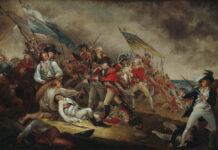The horde of cards was as commonplace as ornaments and lights on the Christmas tree. They would arrive daily sans for Sunday at a half dozen a clip. Initially, it started as a trickle but once the calendar sunk deeper into December, the numbers grew. Many were from people I did not know. By the time Christmas arrived the avalanche of cards became part of our family’s Christmas décor – all in service to induce a sensation of good cheer throughout the Maresca abode.
My mother would string the cards using yarn through the living room and they would decorate every doorway. Leaving nothing to waste once Christmas ended, mom would recycle the cards into tags for gifts for the following Christmas.
There wasn’t a Happy Holidays or Season’s Greetings card among them – at first. The secular Christmas lineup was, however, making some inroads that included such holiday icons as Santa Claus, Rudolph the Red Nosed Reindeer and Frosty the Snowman were among them but remained in the minority.
Originating in Victorian England, these seasonal snail-mail greetings have been a Christmas fixture dating back to the 1840s. Traditional paper Christmas cards have sunk in popularity and if you still practice the art, you remain an atavistic throwback worthy of praise. Writing cards is time consuming but underscores that the relationship is meaningful and worth the effort even though we may not have seen them in decades and may never see them again despite our written promises.
While traditional mailed paper cards have not yet gone the way of the dinosaurs or rotary telephones, they are travelling quickly down a one-way, dead-end street.
Shopping for cards, pens, combing through that old address book and stamps are all an integral part of the ritual. Mom always got a sheet or two of the annual nativity scene postage stamps. She always reminded us to do the same because if we don’t request them, the government would cease making them, which would dishonor the true meaning of the holiday.
Before the digital take over, Christmas cards were turning into a mass-produced and choreographed photograph that had nothing to do with Christmas. Rather, it is a narcissistic chapter-and-verse almanac of the previous year with no personal message and some without a signature.
The temptation to streamline and go to electronic greetings is not just strong but overwhelming. The rise of social media has delivered paper Christmas cards into the dead letter box. The excuses for such behavior are legion, but not surprising. Cards and stamps are not cheap and writing them out is time-consuming. Besides, you are busy.
Sending an electronic greeting is as simple and convenient as it gets. Emails, Instagram, Facebook you name it with a computer’s cut and paste, you can cover more folks than snail mail ever could.
For the social media aficionado, many are animated, impersonal, and soulless but they do check those all-important 21st century boxes of economical and convenient. Nothing says “Merry Christmas” like a holiday selfie tacked on to a laundry list of email addresses.
Deep down you know it’s a utilitarian practice that borders on paganism. The ubiquitous means of electronic communication is efficient, accessible, and cost-conscious, but it is by no means is it traditional, thoughtful, or appealing.
Receiving an electronic Christmas greeting is only vaguely more uplifting than opening spam. Electronic mass greetings are not going away, and neither are football games on Christmas and shopping on Thanksgiving. Once upon a time in America, all were verboten. Today, they are celebrated.
Some will save their electronic cards in cloud archives recalling all those “likes” thumbs up and smiley emojis. However, that is not the same as finding a Christmas or any other hand written card from a generation ago amongst a stack of books or in a photo album.
Since “Merry Christmas” morphed into “Happy Holidays,” Christmas cards have transformed into a more social ritual rather than a religious one. Many come without the reality of the Christ’s nativity. Contemporary America wants to enjoy the birthday party, while ignoring the guest of honor.
Card or no card, this will never change what this sacred day means for the 2.3 billion Christians celebrating worldwide.
Merry Christmas.















































